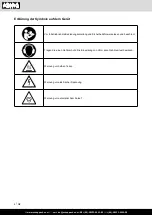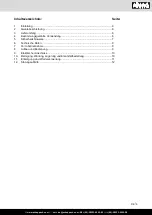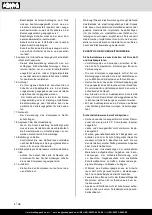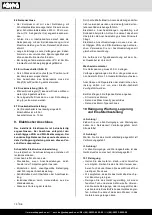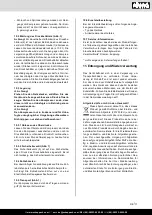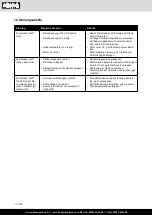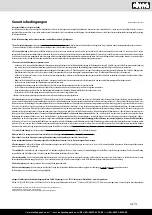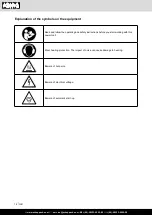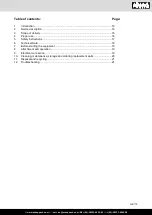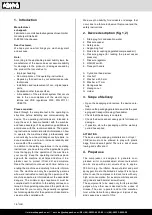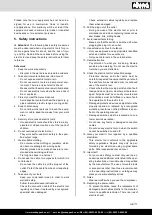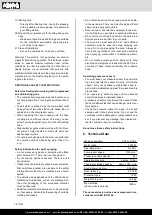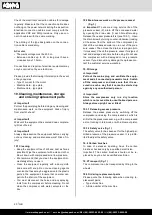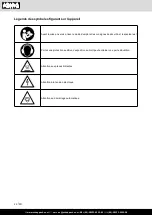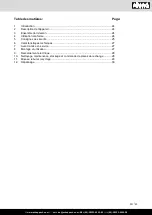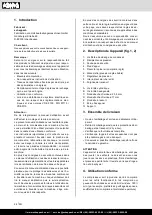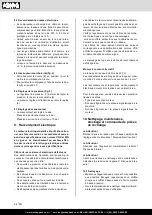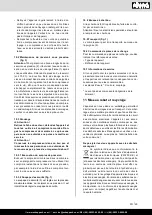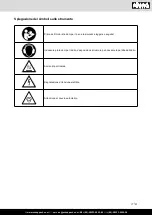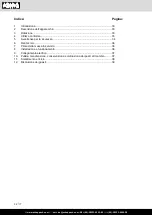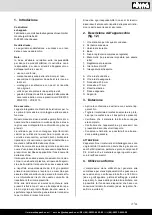
www.scheppach.com /
+(49)-08223-4002-99 /
+(49)-08223-4002-58
18 | GB
19.
Inflating tires
-
Directly after inflating tires, check the pressure
with a suitable pressure gauge, for example at
your filling station.
20. Roadworthy compressors for building site opera-
tions
-
Make sure that all lines and fittings are suitable
for the maximum permissible operating pres-
sure of the compressor.
21. Place of installation
- Set up the compressor on an even surface.
Warning! This electric tool generates an electro-
magnetic field during operation. This field can impair
active or passive medical implants under certain
conditions. In order to prevent the risk of serious or
deadly injuries, we recommend that persons with
medical implants consult with their physician and the
manufacturer of the medical implant prior to operat-
ing the electric tool.
ADDITIONAL SAFETY INSTRUCTIONS
Safety instructions for working with compressed
air and blasting guns
• The compressor pump and lines can become very
hot during operation. Touching these parts will burn
you.
• The air which is sucked in by the compressor must
be kept free of impurities that could cause fires or
explosions in the compressor pump.
• When releasing the hose coupling, hold the hose
coupling piece with your hand. This way, you can
protect yourself against injury from the rebounding
hose.
• Wear safety goggles when working with the blow-
out pistol. Foreign bodies or blown off parts can
easily cause injuries.
• Do not blow at people with the blow-out pistol and
do not clean clothes while being worn. Risk of in-
jury!
Safety information for paint spraying
•
Do not process any paints or solvents with a flash
point below 55° C. There is a risk of explosion!
• Do not heat up paints or solvents. There is a risk
of explosion!
• If hazardous liquids are processed, wear protective
filter units (face guards). Also, adhere to the safety
information provided by the manufacturers of such
liquids.
• The details and designations of the Ordinance on
Hazardous Substances, which are displayed on
the outer packaging of the processed material,
must be observed.
• Additional protective measures are to be undertak-
en if necessary, particularly the wearing of suitable
clothing and masks.
• Do not smoke during the spraying process and/or
in the work area. There is a risk of explosion! Paint
vapours are easily combustible.
• Never set up or operate the equipment in the vicin-
ity of a fire place, open lights or sparking machines.
• Do not store or eat food and drink in the work area.
Paint vapours are harmful to your health.
• The work area must exceed 30 m
3
and sufficient
ventilation must be ensured during spraying and
drying. Do not spray against the wind. Always ad-
here to the regulations of the local police authority
when spraying combustible or hazardous materi-
als.
• Do not process media such as white spirit, butyl
alcohol and methylene chloride with the PVC pres-
sure hose. These media will destroy the pressure
hose.
Operating pressure vessels
• You must keep your pressure vessel in good work-
ing order, operate the vessel correctly, monitor the
vessel, carry out necessary maintenance and re-
pair work immediately and meet the relevant safety
precautions.
• The supervisory authority may enforce essential
control measures in individual cases.
• A pressure vessel is not allowed to be used if it has
faults or deficiencies that can endanger workers or
third parties.
• Check the pressure vessel for signs of rust and
damage each time before using. Do not use the
compressor with a damaged or rusty pressure ves-
sel. If you discover any damage, then please con-
tact the customer service workshop.
Do not lose these safety instructions.
6. Technical Data
Mains connection
230 V~ 50 Hz
Motor rating
1500 W
Operating mode
S3 25%
Compressor speed
3750 min
-1
Pressure vessel capacity
24 l
Operating pressure
approx. 10 bar
Theoretical intake capacity
approx. 180 l/min
Sound power level L
WA
95 dB(A)
Uncertainty K
WA
0.91 dB
Protection type
IP20
Weight of the unit
16.2 kg
Max. altitude
(above mean sea level)
1000 m
The noise emission values were measured in ac-
cordance with EN ISO 3744.

